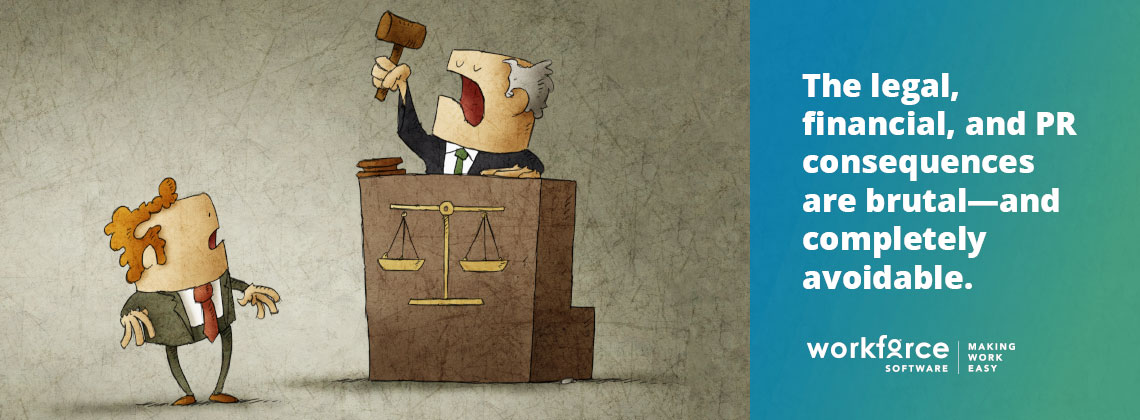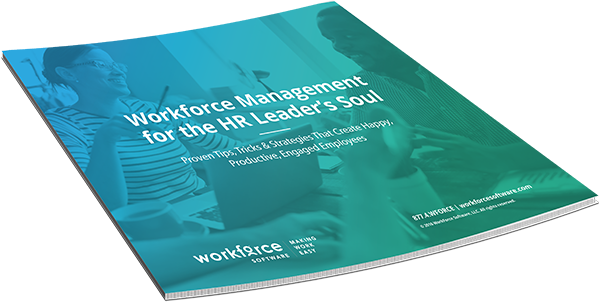WARNING: What Happens When Employers Violate Labor Laws

Ring…
Ring … Ring … Ring …
“Good morning, this is Harold,” said Harry Kline, HR Director.
“Harry, it’s Matt,” said Matthew Anderson, In-House Counsel. “Can we have a meeting?”
“The D.O.L. just called,” said Matt.
A few weeks prior to this conversation, a disgruntled employee contacted the Department of Labor to file a complaint:
The employee said that the company was violating the Fair Labor Standards Act (FLSA) by not correctly calculating his overtime pay, something he claims has happened before.
“I had no idea,” said Harry. “Must’ve slipped through the cracks: We have thousands of employees…”
“Be that as it may, now the D.O.L. wants to schedule a visit,” said Matt. “They want to talk to other workers…”
This happens all the time.
Employers, especially larger organizations, often find themselves in hot water over labor laws.
Usually, it’s not due to malice, but, rather, because there are so many regulations that, as Harry noted, details are sometimes overlooked.
“Employers, especially larger organizations, often find themselves in hot water over labor laws.”
For example, the D.O.L.’s Wage & Hour Division alone enforces numerous major laws, all of which are rightfully designed to protect workers and their families.
That said, employers that take a relaxed or, perhaps, unorganized approach to these important rules may find themselves in violation, which carries consequences…
Subscribe to The WorkForce Blog
Learn the art and science of maintaining productive, happy, engaged employees.
What happens when employers violate labor laws?
The government doesn’t care about why a federal labor law was broken. It’s irrelevant. All that matters is that it happened.
Once a violation is uncovered—whether it involves wages or medical leave or employee safety—legal action has merit.
Employers that violate the law may find themselves dealing with:
1. Litigation, fines and penalties…
If found liable, Harry’s company may be ordered to provide its disgruntled employee with a variety of damages and remedies. For example:
Back Pay: This usually amounts to the sum of lost wages and benefits between the time of the violation and the time at trial.
Value of Lost Benefits: Medical costs, for example.
Cost & Interest: If an employee wins his or her FMLA lawsuit, he or she can recover most costs in connection with the litigation, including filing fees, court reporter fees, witness and subpoena fees, and attorney’s fees.
Of course, the longer the trial goes on, the higher the fees will get. Litigation, however, is just the surface repercussion, a veneer. Typically, the consequences cut deeper, bleeding into other facets of the organization…
2. Demoralized workers…
According to a 2017 survey conducted by WorkForce, 48% of organizations cited concerns over “Declined employee morale” in the aftermath of a labor law mishap.
Taking into account that these laws are designed to protect workers—to keep people happy and safe, to keep things fair—one can see how violating them correlates with a decline in morale.
Even if every worker isn’t technically affected by the infraction, every worker can empathize with its victim(s).
3. Expensive turnover…
Low worker morale = disengaged employees.
“Low worker morale = disengaged employees, people looking for a way out.”
Disengaged employees, typically, are looking for a way out. And if they’re not actively looking, they’re entertaining most opportunities that come their way.
4. Profound brand damage…
Labor violations make for bad press.
In April, 2015, thirteen major retail organizations learned that the hard way. The companies came under fire by the New York attorney general for pervasive use of “on-call” shifts, which, by design, gave employees very little advanced notice regarding their schedules.
The practice stripped employees of control, creating health problems and family dysfunction, among other personal issues. The media had a field day.
Starbucks also had a notable PR nightmare after being accused of leaning on an unfair scheduling practice known as “clopening”, which demands that the employee who closes the store come back the very next morning to open it back up. The public scrutiny was relentless.
 Workforce Management for the HR Leader’s Soul
Workforce Management for the HR Leader’s Soul
This book will help you create a healthy, rewarding environment for the people that keep your company moving forward.
“How do we prevent this from ever happening again?” asked Harry.
He was sitting in a closed-door meeting with a post-trial consultant, a former labor lawyer hired by the company.
“Customize,” said the consultant. “Then automate.”
Cut your losses.
Customize and automate your labor processes.

 Workforce Management for the HR Leader’s Soul
Workforce Management for the HR Leader’s Soul